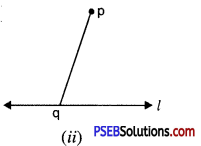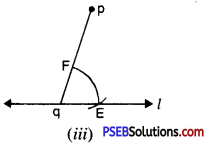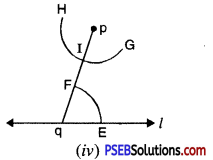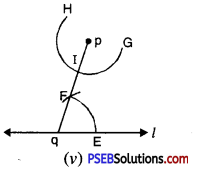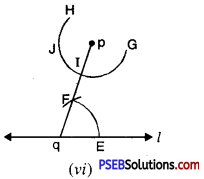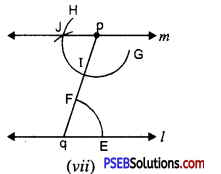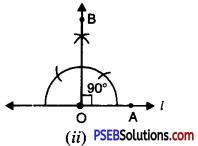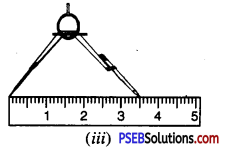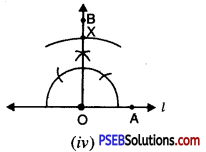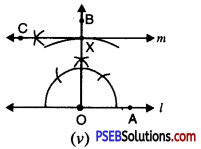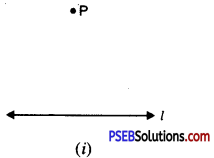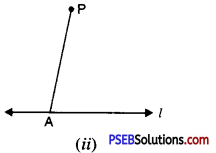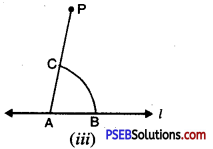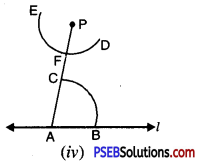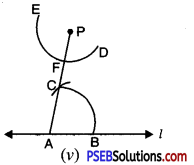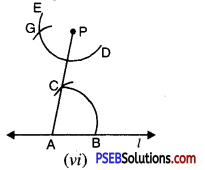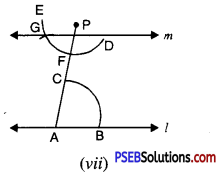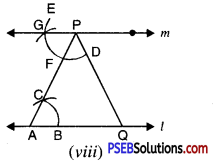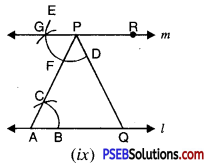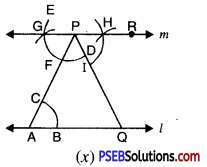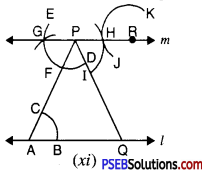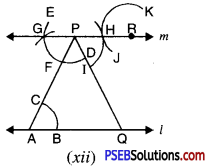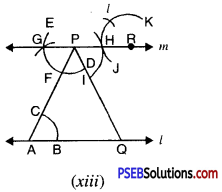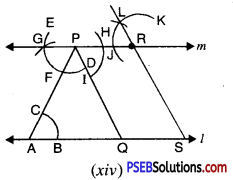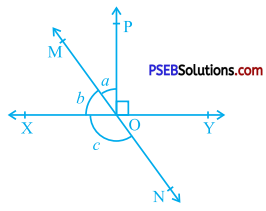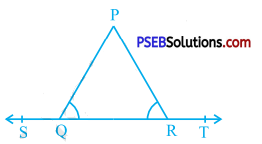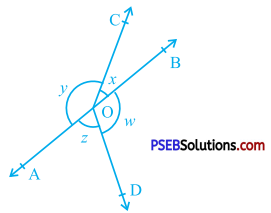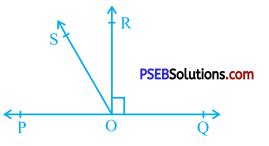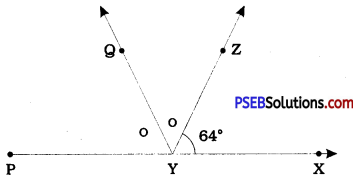Punjab State Board PSEB 10th Class Maths Book Solutions Chapter 3 Pair of Linear Equations in Two Variables Ex 3.6 Textbook Exercise Questions and Answers.
PSEB Solutions for Class 10 Maths Chapter 3 Pair of Linear Equations in Two Variables Ex 3.6
Question 1.
Solve the following pairs of equations by reducing them to a pair of linear equations:
(i) \(\frac{1}{2 x}+\frac{1}{3 y}\) = 2
\(\frac{1}{3 x}+\frac{1}{2 y}=\frac{13}{6}\)
(ii) \(\frac{2}{\sqrt{x}}+\frac{3}{\sqrt{y}}\) = 2
\(\frac{4}{\sqrt{x}}-\frac{9}{\sqrt{y}}\) = -1
(iii) \(\frac{4}{x}\) + 3y = 14
\(\frac{3}{x}\) – 4y = 23
(iv) \(\frac{5}{x-1}+\frac{1}{y-2}\) = 2
\(\frac{6}{x-1}-\frac{3}{y-2}\) = 1
(v) \(\frac{7 x-2 y}{x y}\) = 5
\(\frac{8 x+7 y}{x y}\) = 15
(vi) 6x + 3y = 6xy
2x + 4y = 5xy
(vii) \(\frac{10}{x+y}+\frac{2}{x-y}\) = 4
\(\frac{15}{x+y}-\frac{5}{x-y}\) = -2
(viii) \(\frac{1}{3 x+y}+\frac{1}{3 x-y}=\frac{3}{4}\)
\(\frac{1}{2(3 x+y)}-\frac{1}{2(3 x-y)}=\frac{-1}{8}\)

Solution:
(i) Given pair of linear equations are;
\(\frac{1}{2 x}+\frac{1}{3 y}\) = 2
\(\frac{1}{3 x}+\frac{1}{2 y}=\frac{13}{6}\)
putting \(\frac{1}{x}\) = u and \(\frac{1}{x}\) = v, then equations reduces to
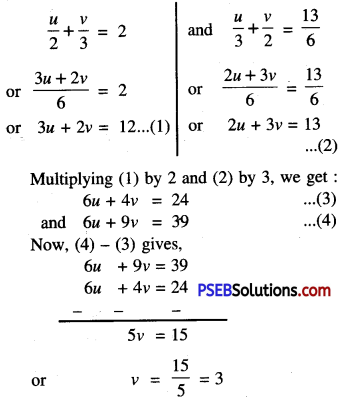
Substitute this value of v in (1), we get:
3u + 2 (3) = 12
or 3u + 6 = 12
or 3u = 12 – 6 = 6
or u = \(\frac{6}{3}\) = 2
But \(\frac{1}{x}\) = u
or x = \(\frac{1}{u}\)
∴ x = \(\frac{1}{2}\)
and \(\frac{1}{y}\) = v
y = \(\frac{1}{v}\)
or y=—\(\frac{1}{3}\)
Hence x = \(\frac{1}{2}\) and y = \(\frac{1}{3}\)

(ii) Given pair of linear equation are
\(\frac{2}{\sqrt{x}}+\frac{3}{\sqrt{y}}\) = 2
\(\frac{4}{\sqrt{x}}-\frac{9}{\sqrt{y}}\) = -1
Putting \(\frac{1}{\sqrt{x}}\) = u and \(\frac{1}{\sqrt{y}}\) = v then equations reduces to
2u + 3v = 2 ……………(1)
and 4u – 9v = -1 ……………(2)
Multiplying (1) by 2, we get:
4u + 6v = 4
Now, (2) – (3) gives
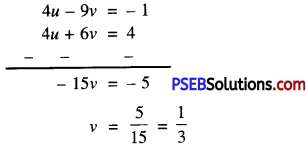
Substitute this value of v in (1), we get:
2u + 3(\(\frac{1}{3}\)) = 2
or 2u + 1 = 2
or 2u = 2 – 1 = 1
or u = \(\frac{1}{2}\)
But \(\frac{1}{\sqrt{x}}\) = u
or (\(\frac{1}{\sqrt{x}}\))2 = u2
or \(\frac{1}{x}\) = u2
or \(\frac{1}{x}\) = (\(\frac{1}{2}\))2
or x = 4
and \(\frac{1}{\sqrt{y}}\) = v
or (\(\frac{1}{\sqrt{y}}\))2 = v2
or \(\frac{1}{y}\) = v2
or \(\frac{1}{y}\) = (\(\frac{1}{3}\))2
or y = 9
Hence x = 4 and y = 9.

(iii) Given pair of linear equations are
\(\frac{4}{x}\) + 3y = 14 and \(\frac{3}{x}\) – 4y = 23
putting \(\frac{1}{y}\) = v then equations reduces to
4v + 3y = 14 ………..(1)
and 3v – 4y = 23 ……………(2)
Multiplying (1) by 3 and (2) by 4, we get:
12v + 9y = 42 ………..(3)
and 12v – 16y = 92 ……………..(4)
Now, (4) – (3) gives
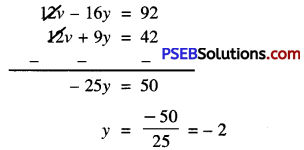
Substitute this value of y in (1), we get:
4v + 3(-2) = 14
or 4v – 6 = 14
or 4v = 14 + 6 = 20
or v = \(\frac{20}{4}\) = 5
But \(\frac{1}{x}\) = v
x = \(\frac{1}{v}\) = \(\frac{1}{5}\)
Hence x = \(\frac{1}{5}\) and y = -2.

(iv) Given pair of linear equation are
\(\frac{5}{x-1}+\frac{1}{y-2}\) = 2 and \(\frac{6}{x-1}-\frac{3}{y-2}\) = 12
Putting \(\frac{1}{x-1}\) = u and \(\frac{1}{y-2}\) = v then equations reduces to
5u + v = 2 ……………(1)
and 6u – 3v = 1 ……………(2)
Multiplying (1) by 3, we get:
15u + 3v = 6 ………..(3)
Now, (3) + (2) gives

u = \(\frac{7}{21}=\frac{1}{3}\)
Substitute this value of u in (1), we get:
5 × \(\frac{1}{3}\) + v = 2
or v = 2 – \(\frac{5}{3}\) = \(\frac{6-5}{3}\)
or v = \(\frac{1}{3}\)
But \(\frac{1}{x-1}\) = u
or \(\frac{1}{x-1}\) = \(\frac{1}{3}\)
or x – 1 = 3
or x = 3 + 1
or x = 4
and \(\frac{1}{y-2}\) = v
or \(\frac{1}{y-2}\) = \(\frac{1}{3}\)
or y – 2 = 3
or y = 3 + 2
or y = 5
Hence x = 4 or y = 5.

(v) Given pair of linear equation are
\(\frac{7 x-2 y}{x y}\) = 5
or \(\frac{7 x}{x y}-\frac{2 y}{x y}\) = 5
or \(\frac{7}{y}-\frac{2}{x}\) = 5
or \(-\frac{2}{x}+\frac{7}{y}\) = 5
and \(\frac{8 x+7 y}{x y}\) = 15
or \(\frac{8 x}{x y}+\frac{7 y}{x y}\) = 15
or \(\frac{8}{y}+\frac{7}{x}\) = 15
or \(\frac{7}{x}+\frac{8}{y}\) = 15
Putting \(\frac{1}{x}\) = u and \(\frac{1}{y}\) = v, then equations reduces to
-2u + 7v = 5 ………….(1)
and 7u + 8v = 15 ………….(2)
Multiplying (1) by 7 and (2) by 2, we get:
-14v + 49u = 35
and 14v + 16u = 30
Now, (3) + (4) gives,
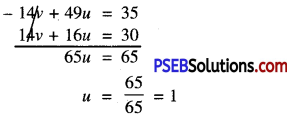
Substitute thuis value of u in (1), we get:
-2(1) + 7v = 5
or 7v = 5 + 2
or 7v = 7
or v = \(\frac{7}{7}\) = 1
But \(\frac{1}{x}\) = u
or x = \(\frac{1}{u}\)
or x = \(\frac{1}{1}\)
or x = 1
and \(\frac{1}{y}\) = v
or y = \(\frac{1}{v}\)
or y = \(\frac{1}{1}\)
or y = 1
Hence x = 1 and y = 1.
(vi) Given pair of linear equations are
6x + 3y = 6xy
or \(\frac{6 x+3 y}{x y}=\frac{6 x y}{x y}\)
or \(\frac{6}{y}+\frac{3}{x}=6\)
or \(3\left[\frac{1}{x}+\frac{2}{y}\right]=6\)
or \(\frac{1}{x}+\frac{2}{y}=2\)
and 2x + 4y = 5xy
or \(\frac{2 x+4 y}{x y}=\frac{5 x y}{x y}\)
or \(\frac{2}{y}+\frac{4}{x}=5\)
or \(\frac{4}{x}+\frac{2}{y}=5\)
Putting \(\frac{1}{x}\) = u and \(\frac{1}{y}\) = v, then equations reduces to
u + 2v = 2 ……………(1)
and 4u + 2v = 5 ……….(2)
Now, (2) – (1) gives

or u = \(\frac{3}{3}\) = 1
Substitute this value of u in (1), we get:
1 + 2v = 2
or 2v = 2 – 1
or v = \(\frac{1}{2}\)
But \(\frac{1}{x}\) = u
or \(\frac{1}{x}\) = 1
or x = 1
and \(\frac{1}{y}\) = v
or \(\frac{1}{y}\) = \(\frac{1}{2}\)
or y = 2
Hence x = 1 and y = 2.

(vii) Given pair of linear equations are
\(\frac{10}{x+y}+\frac{2}{x-y}\) = 4
\(\frac{15}{x+y}-\frac{5}{x-y}\) = -2
Putting \(\frac{1}{x+y}\) = u and \(\frac{1}{x-y}\) = v, then equations reduces to
10u + 2v = 4 or
5u + v = 2 …………(1)
15u – 5v = -2 ………….(2)
Multiplying (1) by 5, we get
25u + 5v = 10 ………….(3)
Now, (3) + (2) gives
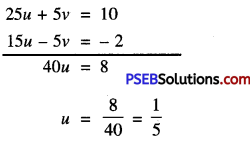
Substitute this value of u in (1), we get:
5(\(\frac{1}{5}\)) + v = 2
or 1 + v = 2
or v = 1
But \(\frac{1}{x+y}\) = u
or \(\frac{1}{x+y}\) = \(\frac{1}{5}\)
or x + y = 5 ……….(4)
and \(\frac{1}{x-y}\) = v
or \(\frac{1}{x-y}\) = 1
or x – y = 1 ………..(5)
Now, (4) + (5) gives
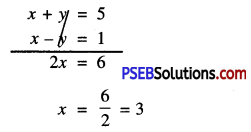
Substitute this value of x in (4), we get:
3 + y = 5
y = 5 – 3 = 2
Hence x = 3 and y = 2.
(viii) Given pair of linear equations are
\(\frac{1}{3 x+y}+\frac{1}{3 x-y}=\frac{3}{4}\) and \(\frac{1}{2(3 x+y)}-\frac{1}{2(3 x-y)}=\frac{-1}{8}\)
Putting \(\frac{1}{3 x+y}\) = u and \(\frac{1}{3 x-y}\) = y, then Equations reduces to
u + v = \(\frac{3}{4}\)
or 4u + 4v = 3
or 4u + 4v = 3 ………….(1)
and \(\frac{u}{2}-\frac{v}{2}=\frac{-1}{8}\)
or u – v = \(\frac{-1}{4}\)
or 4u – 4v = -1 ………………(2)
Now, (1) + (2) gives
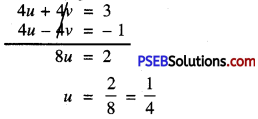
Substitute this value of u in (1), we get:
4(\(\frac{1}{4}\)) + 4v = 3
or 4v = 2
or v = \(\frac{2}{4}=\frac{1}{2}\)
But \(\frac{1}{3 x+y}\) = \(\frac{1}{4}\)
or 3x + y = 4 …………(3)
and \(\frac{1}{3 x-y}\) = \(\frac{1}{2}\)
or 3x – y = 2 …………….(4)
Now, (3) + (4) gives

x = 1
Substitute this value of x in (3), we get:
3(1) + y = 4
or 3 + y = 4
or y = 4 – 3 = 1
Hence, x = 1 and y = 1.

Question 2.
Formulate the following problems as a pair of equations, and hence find their solutions.
(i) Ritu can row downstream 20 km in 2 hours, and upstream 4 km In 2 hours. Find her speed of rowing in still water and the speed of the current.
(ii) 2 women and 5 men can together finish an embroidery work in 4 days, while 3 women and 6 men can finish it in 3 days. Find the time taken by 1 woman alone to finish the work, and also that taken by 1 man alone.
(iii) Roohi travels 300 km to her home party by train and partly by bus. She takes 4 hours if she travels 60 km by train and the remaining by bus. If she travels 100 km by train and the remaining by bus, she takes 10 minutes longer. Find the speed of the train and the bus separately.

Solution:
(i) Let the speed of Ritu in still water = x km/hour
and the speed of current = y km/hour
∴ speed in upstream = (x – y) km/hour
and speed in downstream = (x + y) km/hour
Distance covered by Ritu in downstream in 2 hours = Speed × Time
= (x + y) × 2 km
According to 1st condition
2(x + y) = 20
x + y = 10 ……………..(1)
Distance covered by Rim in upstream in 2 hours
= Speed × Time
= 2(x – y)km
According to 2nd condition,
2(x – y) =4
x – y = 2 ……………….(2)
Now, (1) + (2) gives
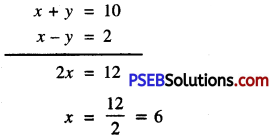
Substitute this value of x in (1), we get:
6 + y = 10
y = 10 – 6 = 4
Hence, Ritu’s speed in still water = 6 km/hour
and speed of current = 4 km/hour.
(ii) Let one woman can fmish the work = x days
One man can finish the work = y days
then one woman’s one day’s work = \(\frac{1}{x}\)
One man’s one day’s work = \(\frac{1}{y}\)
According to 1st condition,
\(\frac{2}{x}+\frac{5}{y}=\frac{1}{4}\) ……………(1)
According to 2nd equation
\(\frac{3}{x}+\frac{6}{y}=\frac{1}{3}\) ……………(2)
Putting \(\frac{1}{x}\) = u and \(\frac{1}{y}\) = v, then equations (1) and (2) reduces to
2u + 5v = \(\frac{1}{4}\)
8u + 20v = 1 …………….(3)
and 3u + 6v = \(\frac{1}{3}\)
9u + 18v = 1 ……………..(4)
Multiplying (3) by 9 and (4) by 8, we get:
72u + 180v = 9 ……………..(5)
and 72u + 144v = 8 …………..(6)
Now, (5) – (6) gives
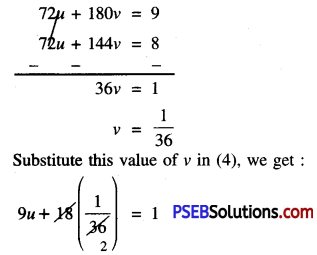
or 9u + \(\frac{1}{2}\) = 1
or 9u = 1 – \(\frac{1}{2}\) = \(\frac{2-1}{2}\)
or 9u = \(\frac{1}{2}\)
or u = \(\frac{1}{2 \times 9}=\frac{1}{18}\)
But \(\frac{1}{x}\) = u
or \(\frac{1}{x}\) = \(\frac{1}{18}\)
or x = 18
and \(\frac{1}{y}\) = v
\(\frac{1}{y}\) = \(\frac{1}{36}\)
or y = 36
Hence, one woman and one man alone can finish work in 18 days and 36 days respectively.

(iii) Let speed of train = x km/hour
and speed of bus = y km/hour
Total distance = 300 km
Case I:
Time taken by train to cover 60 km = \(\frac{\text { Distance }}{\text { Speed }}\)
= \(\frac{60}{x}\) hours
Time taken by bus to cover 240 km = (300 – 60) = \(\frac{240}{y}\) hours
Total time = \(\left(\frac{60}{x}+\frac{240}{y}\right)\) hours
According to 1st condition,
\(\frac{60}{x}+\frac{240}{y}\) = 4
\(\frac{15}{x}+\frac{60}{y}\) = 1 ……………….(1)
Case II:
Time taken by train to cover 100 km = \(\frac{100}{x}\) hours
Time taken by bus to cover 200 km = 300 – 100 = \(\frac{200}{y}\) hours
∴ Total time = \(\left(\frac{100}{x}+\frac{200}{y}\right)\) hours
According to 2nd condition,
\(\left(\frac{100}{x}+\frac{200}{y}\right)\) = 4 hours 10 minutes
or \(\left(\frac{100}{x}+\frac{200}{y}\right)\) = \(\frac{25}{6}\)
\(\left(\frac{24}{x}+\frac{48}{y}\right)\) = 1 ……….(2)
Putting \(\frac{1}{x}\) = u and \(\frac{1}{y}\) = v in equations
(1) and (2) then equations reduces to
15u + 60v = 1
and 24u + 48v = 1
15u + 60v – 1 = 0
24u + 48v – 1 = 0
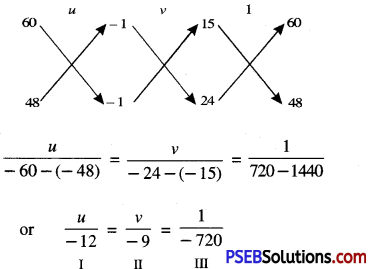
From I and III, we get:
\(\frac{u}{-12}=\frac{1}{-720}\)
⇒ u = \(\frac{12}{720}=\frac{1}{60}\)
From II and III, we get:
\(\frac{v}{-9}=\frac{1}{-720}\)
⇒ v = \(\frac{9}{720}=\frac{1}{80}\)
But \(\frac{1}{x}\) = u
or \(\frac{1}{x}\) = \(\frac{1}{u}\)
or x = 60
and \(\frac{1}{y}\) = v
or \(\frac{1}{y}\) = \(\frac{1}{80}\)
or y = 80
Hence, speed of train and bus are 60 km/hour and 80 km/hour respectively.
![]()
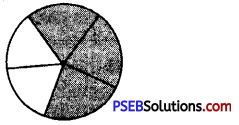
![]()
![]()


